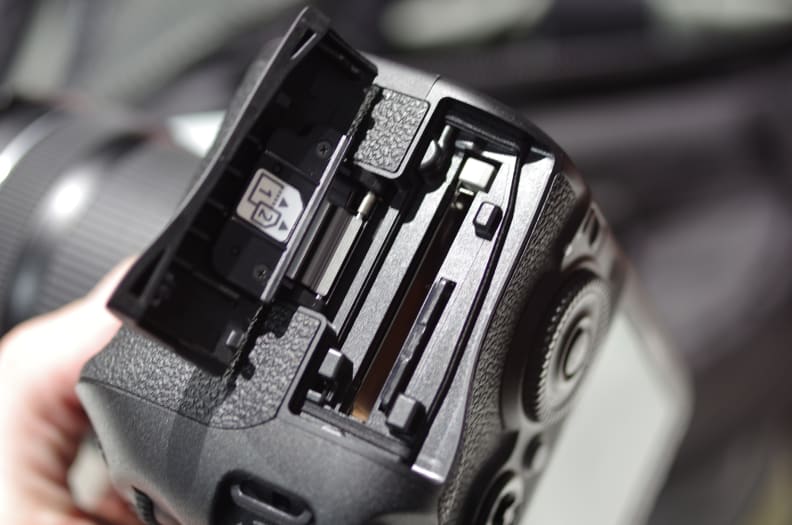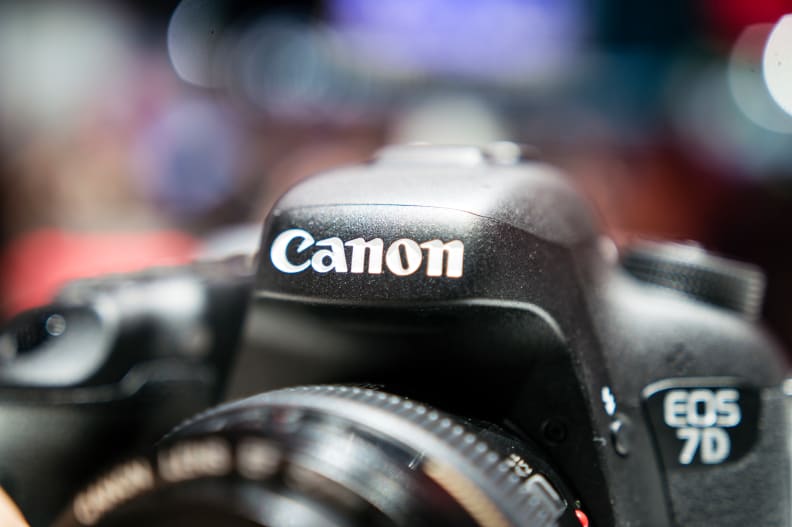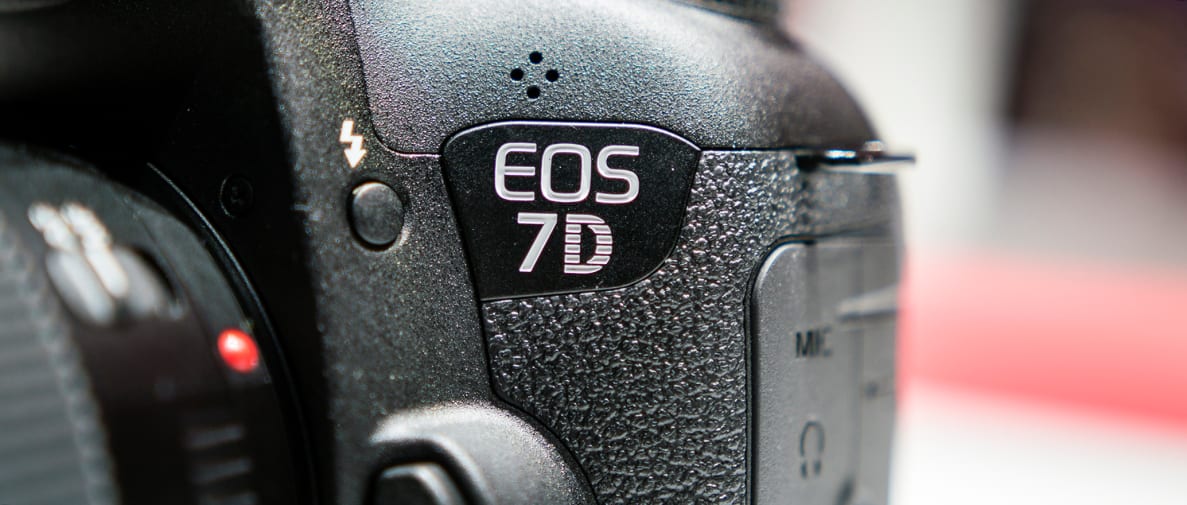Pros
Cons
It's as if a prophecy has been fulfilled for the Canon Kingdom.
As Canon fans rejoiced over the highly-anticipated revamp, we headed to Photokina 2014 in Cologne, Germany to get our hands on this worthy successor to the SLR video throne.
{{brightcove '3789902244001'}}
Design and Handling
Bask in the familiar warmth of your EOS security blanket.
As soon as we saw the 7D Mark II, we noticed how close the design is to the 5D Mark III. Many of the upgrades that 5D users got with the Mark III have been introduced to the 7D with this latest installment. In fact, the 7D also looks nearly identical to the original 7D. One way or another, if you're already using a mid-range Canon made in the last 5 years, you will be very familiar with the 7D Mark II. Canon knows what its users like and is sticking to that design.
As is the case with many SLRs, the 7D Mark II has a control dial for your index finger and classic rear wheel for controlling with the thumb. Canon added a focus mode lever to the rear of the camera–next to the directional pad–to quickly switch between focus modes.
Canon also added something that we know everyone wanted on the new 7D: dual memory card slots. You can now use an SD and CF card to choose between media types, set one card as an overflow, capture different qualities on each, or keep a backup with copies on both. This is a huge addition for both people shooting video and stills as corrupt cards can strike at any time.

The 7D Mark II has slots for both a CF and SD card.
While handling the 7D Mark II, we noticed that it was a bit thicker in the grip area and weighed a bit more than its predecessor. Of course, some full-frame users love the weight of their cameras, but others will regret the added encumbrance. Personally, I've been using professional-grade DSLRs for my whole career and love the weight of this camera. If you're stepping up from a smaller system, you'll find the 7D a bit on the heavy side no matter what.
Canon also upped the professional caliber of the 7D by increasing the dust and water resistance of the Mark II, encouraging shooters to use it more often in less-than-friendly environments.
{{ photo_gallery name="Samples" }}
The viewfinder on the 7D Mark II has nearly 100% coverage area and has a customizable HUD allowing you to view and change settings without pulling the camera away from your eye to check the secondary LCD. This works well in practice, as I scanned the showroom floor firing off shots at 10fps, unimpeded by the action of changing shutter speed. Being able to change the information display style will help more users be comfortable with this.
The rear LCD also received a bit of a resolution bump, but may be a disappointment to video users. The good news? Now at 720p, it is officially an HD screen. The bad news? The 7D II did not inherit a touch and/or tilt screen.
Features
One of the first things we did with the 7D Mark II was test the continuous shooting. We had heard how fast and efficient it was from Canon, so we decided to try it out ourselves in the fast-paced environment of Photokina. We were pretty impressed with how the camera felt when firing off 10fps. It wasn't jarring, and it wasn't harder to handle. It felt far smoother than other DSLRs we've handled shooting near these speeds.
For the first time in an EOS camera, Canon has implemented a 65-point autofocus system where every single point is cross-type sensitive. That's actually technically better than the AF system in Canon's flagship, the EOS-1D X, which only has 21 cross-type AF points. It also shares the same Intelligent Tracking and Recognition Auto Focus (iTR EOS) technology as the EOS-1D X.

The hotshoe allows for a range of accessories from external lighting for photographers to a shotgun mic for videos.
Of course, for many Canon devotees, the true merit of the 7D Mark II will be video. Keep in mind that we couldn't keep the video footage that we shot, but from what we could tell on-camera, the video performance was spot-on and the manual controls intuitive.
Another upgrade that the 7D received was the Dual Pixel AF, which gives an even bigger boost to video capture. Only the EOS 70D and EOS cinema cameras had this feature until now—a feature that very much improved the focus experience of video shooters on those cameras. Unfortunately, the 70D maintains a distinct advantage: its touchscreen allows you to choose a point on the screen and slowly rack focus to the desired point.

The 7D Mark II has connections for headphones, mics, USB, HDMI, flash sync, and remote control.
When it comes to video quality options, there are plenty. You can shoot either MOV or MP4 formats at 1080p (59.94fps / 29.97fps / 24.00fps / 23.98fps), 720p (59.94fps), 480p (29.97fps), or you can record uncompressed HDMI to an external recorder.
There are even different codecs available for these different qualities, which makes all the difference for many video gurus. IPB, All-I, and Light (IPB) are all based on the fps/quality you choose. All MOV footage uses IPB and All-I, whereas MP4 uses a mixture of all three for different qualities. If you're unfamiliar with these terms and what they mean for your video, Canon has some information here.
And let's not forget this added perk: You can simultaneously record two different qualities on your two different memory cards.
Conclusion
The 7D Mark II enters the market at a very interesting time for Canon. Full-frame sensors have been moving downmarket, thanks in no small part to Canon's own EOS 6D. Where does a flagship-level APS-C camera even fit in? After spending quite a bit of time with the 7D Mark II here in Cologne, we're confident that the demise of high-end APS-C cameras is overblown.
The 7D is a flagship device perfect for enthusiast and professional photographers who need a camera that can shoot fast, focus quickly, and take the kind of day-to-day beating that pros routinely dish out. If the 7D Mark II has one problem it's that it's stuck living in the shadow of its iconic predecessor... and under the weight of five years of hopeful, impatient fans; rarely can any sequel handle that kind of build-up.
The 7D Mark II may not please every Canon fan, but it's a credible upgrade that brings a significant amount of technology from the 1D X and puts it within reach of everyday people. We love that it has a mixture of technologies that are well above its price range and that Canon continued to make it a great DSLR for videographers and action shooters. Even with the original 7D still selling on Amazon for cut-rate prices, the new Mark II seems to be absolutely worth the investment.

That said, we certainly look forward to seeing what the 7D Mark II can do in our labs. Considering the original 7D is still near the head of the class—5 years after its release—we have high expectations for how the newer, faster, and smarter version will do.
Meet the tester
As a photojournalist, Jackson has had stints working with bands, the military, and professional baseball teams before landing with Reviewed. Outside of Reviewed, he can be found looking for the next game to relieve his "Gamer ADD" or growing his beard.
Checking our work.
Our team is here to help you buy the best stuff and love what you own. Our writers, editors, and experts obsess over the products we cover to make sure you're confident and satisfied. Have a different opinion about something we recommend? Email us and we'll compare notes.
Shoot us an email


